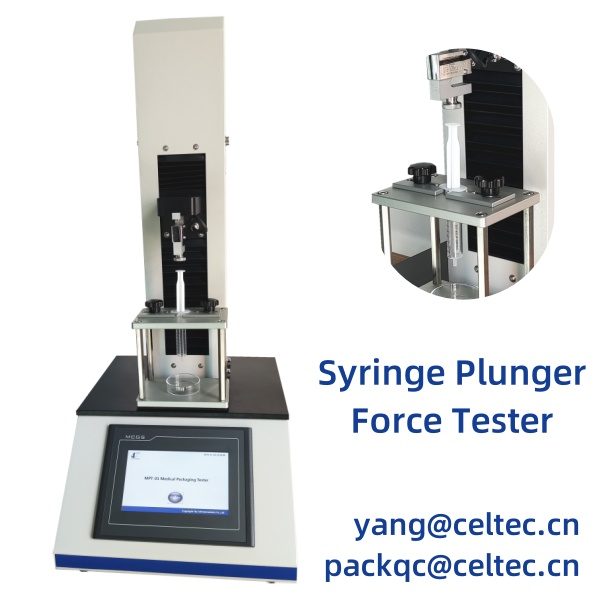Understanding Syringe Plunger Force: Key Insights from USP 382 and ISO 7886-1
The accuracy and reliability of medical devices are paramount, particularly for syringes, which are widely used in various medical and pharmaceutical applications. One critical aspect of ensuring syringe functionality is the syringe plunger force test. This article delves into the intricacies of this test, drawing insights from the standards USP 382 and ISO 7886-1.
I. Syringe Plunger Force: A Crucial Metric in Medical Device Testing
Syringe plunger force is a critical measure that ensures the smooth and effective operation of syringes. This metric assesses the force required to move the plunger within the syringe barrel, ensuring that the syringe can deliver medication without requiring excessive effort, which could compromise patient safety.
1. Understanding USP 382 and ISO 7886-1
USP 382 and ISO 7886-1 provide comprehensive guidelines for testing the performance and safety of syringes, specifically focusing on the force required to operate the plunger.
2. Overview of USP 382
USP 382, established by the United States Pharmacopeia, outlines the test methods and acceptance criteria for syringe plunger force. It ensures that syringes perform reliably under various conditions, providing a standard benchmark for manufacturers and quality assurance professionals.
3. ISO 7886-1 Specifications
ISO 7886-1, an international standard, specifies the test methods for single-use syringes. Annex E of this standard details the procedure for determining the forces required to operate the piston, emphasizing the importance of controlled testing conditions to obtain accurate and reproducible results.
II. The Importance of Syringe Plunger Force Testing
Syringe plunger force testing is vital for several reasons:
- Patient Safety: Ensures that syringes can be operated smoothly without excessive force, reducing the risk of injury or improper medication delivery.
- Quality Assurance: Helps manufacturers maintain consistent quality across production batches.
- Regulatory Compliance: Ensures compliance with industry standards such as USP 382 and ISO 7886-1, which are critical for market approval.
III. Test Methods and Procedures
1. Calibration and Setup
Before testing, the Syringe Plunger Force Tester must be calibrated to the specific syringe size and type. This step ensures that the test results are accurate and relevant to the syringe being evaluated.
2. Testing Process
- Placement: Secure the syringe in the testing fixture of the MST-01 Syringe Plunger Force Tester.
- Initiation: Start the test to measure the force required to move the plunger through the barrel.
- Measurement: The instrument records the force exerted throughout the plunger’s movement, providing real-time data.
3. Data Interpretation and Analysis
The data obtained from the syringe plunger force test include several key metrics:
- Initial Force: The force required to start moving the plunger.
- Maximum Force: The highest force recorded during the plunger’s movement.
- Sustained Force: The force required to maintain the plunger’s movement.
By analyzing these metrics, users can determine whether a syringe meets the necessary performance standards. The data can be exported for further analysis and reporting.
IV. Applications in Various Industries
1. Medical Device Testing
In medical device testing, the syringe plunger force test ensures that syringes are safe and effective for patient use. It verifies that the syringe can deliver medication accurately without requiring excessive force.
2. Pharmaceutical Industry
The test is crucial in the pharmaceutical industry to ensure that syringes used for drug delivery meet the required standards, ensuring patient safety and effective medication administration.
3. Quality Control
Manufacturers rely on the syringe plunger force test to maintain high-quality control standards, ensuring each syringe batch meets regulatory requirements and industry standards.
4. Research and Development
In R&D settings, the syringe plunger force test supports the development of new syringe designs and technologies, providing crucial data to inform product improvements.
V. Cell Instruments MST-01 Syringe Plunger Force Tester
The MST-01 Syringe Plunger Force Tester by Cell Instruments is designed to meet the rigorous demands of medical device testing. It provides precise measurements of the force needed to push the plunger of a syringe, ensuring high standards of performance and safety.
Customization and Automation Solutions
1. Customization Options
Cell Instruments offers customization options to meet specific testing needs, adapting the tester for different syringe sizes or integrating additional features.
2. Automation Transformation Services
To enhance productivity, Cell Instruments provides automation transformation services. Automating the testing process increases efficiency, improves consistency, and reduces human error, ensuring reliable and repeatable results.
FAQ
A1: Syringe plunger force is crucial for ensuring that syringes operate smoothly and deliver medication effectively without requiring excessive force, which can compromise patient safety.
A2: USP 382 and ISO 7886-1 are the primary standards that outline the requirements and test methods for syringe plunger force.
A3: The test involves securing the syringe in a testing fixture, initiating the test to measure the force required to move the plunger, and recording the force exerted throughout the plunger’s movement.
A4: Key metrics include initial force, maximum force, and sustained force, which are used to determine if a syringe meets performance standards.
A5: Yes, Cell Instruments offers customization options to meet specific testing needs, including adapting the tester for different syringe sizes and integrating additional features.

